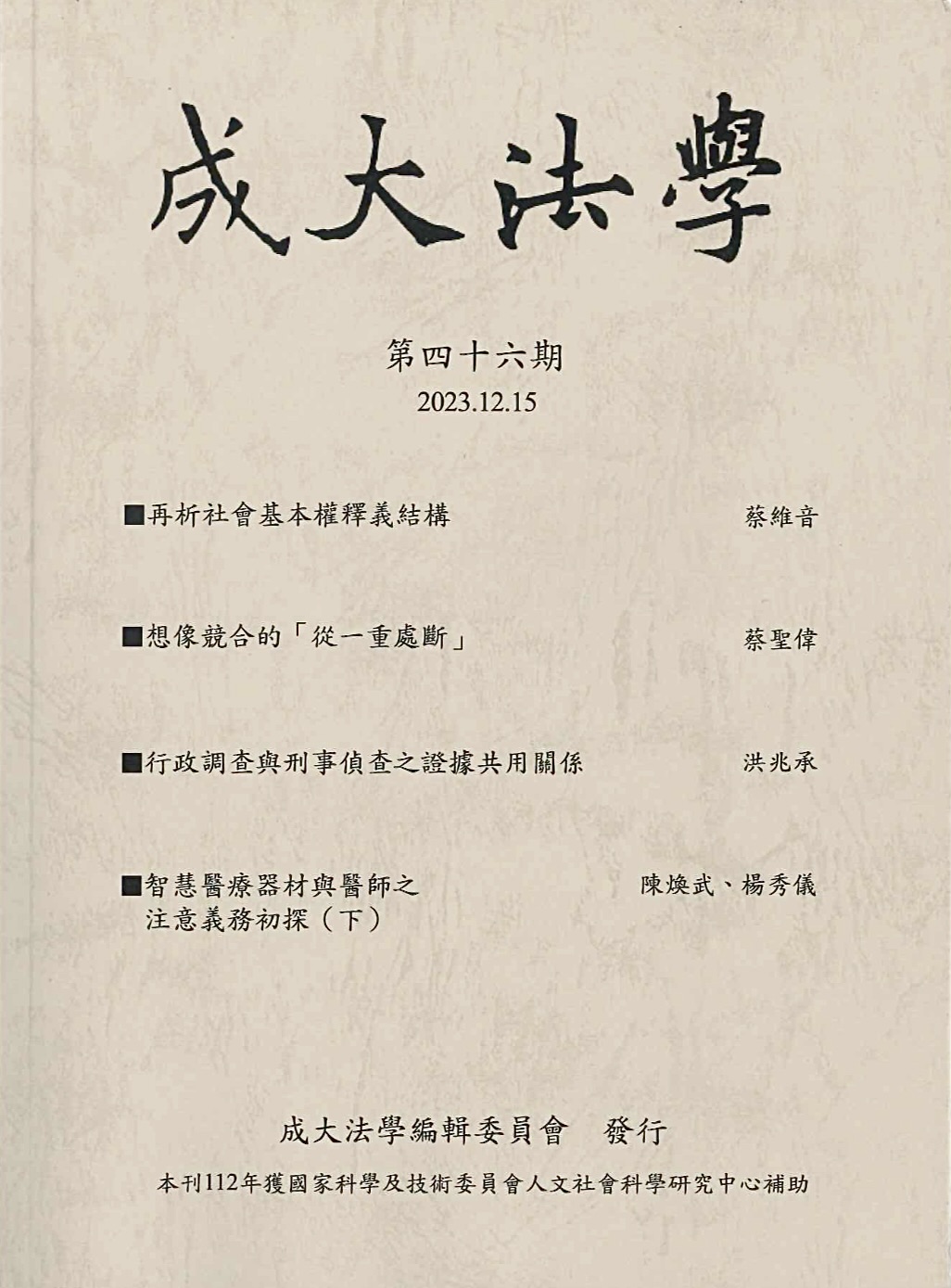前期出版
前期出版
頁數:﹣
想像競合的「從一重處斷」
The Legal Effect of Article 55 of the Criminal Law
研究論文
作者(中)
蔡聖偉
作者(英)
Sheng-Wei Tsai
關鍵詞(中)
想像競合、從一重處斷、組合原則、競合理論(罪數論)、真正競合
關鍵詞(英)
Concurrence of Offenses (Idealkonkurrenz, Tateinheit), Severe Penalties, Combination Principle (Konbinationsprinzip), Theory of Coopetition (Konkurrenzlehre), Real Coopetition (Echte Konkurrenz)
中文摘要
立法者將想像競合的情形規定於刑法第55條,搭配的法律效果為「從一重處斷」。這短短五個字有不同的詮釋可能,隨而在部分問題上會分別導出不同結論。依照本文看法,想像競合本質上屬真正競合,其中的所有罪名,無論輕重,均屬成立且得以適用。在此理解基礎上,「從一重處斷」就是對於異種想像競合的情形,指示法律適用者如何劃定主刑量刑框架(上限和下限),以形成單一主刑的技術性規則,而不是用來決定何法條得以適用或應成立何罪。依照這個主刑框架的指示規則,法院要在所有罪名的法律效果之間,找出最重的法律效果組合,沒有理由必須侷限於單一條文所規定的法律效果。
在具體操作時,應分成兩個階段。首先,要根據刑罰的種類,挑選出最重的「刑種組合」。其次,再從所有罪名的適用刑度中,將同種類刑罰的最重上限和最重下限分別挑出,組合成該種刑罰類別的量刑框架。這些界限額度通常是出自同一個條文,但不必然如此。依此,縱使僅較輕罪名設有併科罰金、從刑、沒收或保安處分之效果,但重罪無,由於該等效果業已明文規定於部分法條中,法院自可(且應)依照此等規定併予宣告,並不會有違反罪刑法定的問題。
在具體操作時,應分成兩個階段。首先,要根據刑罰的種類,挑選出最重的「刑種組合」。其次,再從所有罪名的適用刑度中,將同種類刑罰的最重上限和最重下限分別挑出,組合成該種刑罰類別的量刑框架。這些界限額度通常是出自同一個條文,但不必然如此。依此,縱使僅較輕罪名設有併科罰金、從刑、沒收或保安處分之效果,但重罪無,由於該等效果業已明文規定於部分法條中,法院自可(且應)依照此等規定併予宣告,並不會有違反罪刑法定的問題。
英文摘要
The legal effect of “Idealkonkurrenz” in Article 55 of the Criminal Law in Taiwan is that the punishment imposed in the end shall not be less than the minimum punishment for the least severe offense. This statute looks plain on its face, but has different possible interpretations. Different interpretations lead to different applications of this statute, which are responsible for inconsistent court judgements in the past.
This article argues that “Idealkonkurrenz” in Article 55 is essentially an “echte Konkurrenz”. That is, all offenses proved are legally established. Based on this interpretation, Article 55 is meant to delineate the sentencing framework (maximum and minimum punishment) for the court. The court shall thus find the most severe combination of legal effects of all established offenses, instead of being constrained by the legal effect of one single proved offense.
Specifically speaking, when the court applies Article 55, it shall go through two stages of sentencing. At the first stage, the court shall calculate the most severe combination of punishment of all offenses established. At the second stage, the court shall select the maximum and minimum of the same type of penalty. The maximum and minimum of the same type of penalty are usually, but not necessarily, derived from the same statute. However, if the less severe offense provides for accessory punishment, such as confiscation, security measures, and compulsory medical treatments, the court could still include accessory punishments in its final sentence. As to the possible constitutional issue, since these legal effects have been stipulated in statutes involved, the sentence of the court will not violate the principle of legality mandated by the Constitution.
This article argues that “Idealkonkurrenz” in Article 55 is essentially an “echte Konkurrenz”. That is, all offenses proved are legally established. Based on this interpretation, Article 55 is meant to delineate the sentencing framework (maximum and minimum punishment) for the court. The court shall thus find the most severe combination of legal effects of all established offenses, instead of being constrained by the legal effect of one single proved offense.
Specifically speaking, when the court applies Article 55, it shall go through two stages of sentencing. At the first stage, the court shall calculate the most severe combination of punishment of all offenses established. At the second stage, the court shall select the maximum and minimum of the same type of penalty. The maximum and minimum of the same type of penalty are usually, but not necessarily, derived from the same statute. However, if the less severe offense provides for accessory punishment, such as confiscation, security measures, and compulsory medical treatments, the court could still include accessory punishments in its final sentence. As to the possible constitutional issue, since these legal effects have been stipulated in statutes involved, the sentence of the court will not violate the principle of legality mandated by the Constitution.
線上閱覽
全文下載get_app
1.全文公開下載




